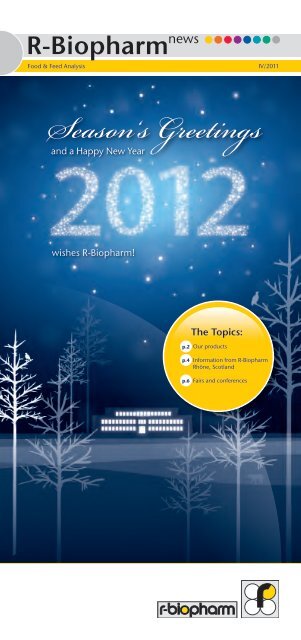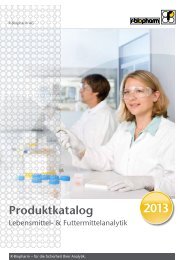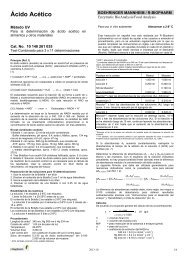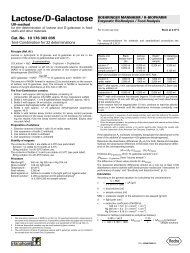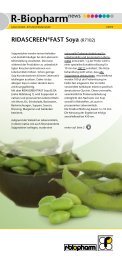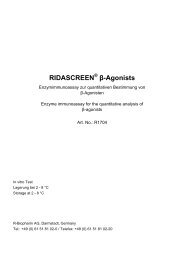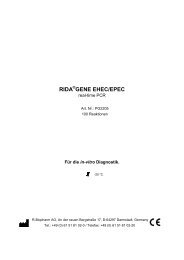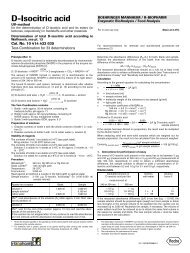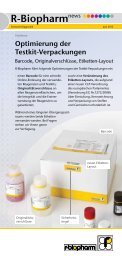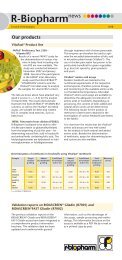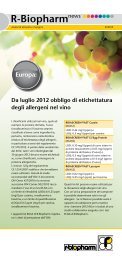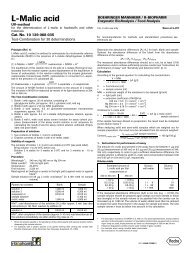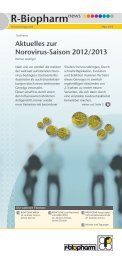Information from R-Biopharm Rhône (RBR ... - R-Biopharm AG
Information from R-Biopharm Rhône (RBR ... - R-Biopharm AG
Information from R-Biopharm Rhône (RBR ... - R-Biopharm AG
You also want an ePaper? Increase the reach of your titles
YUMPU automatically turns print PDFs into web optimized ePapers that Google loves.
Food & Feed Analysis Juni/2007 IV/2011<br />
and a Happy New Year<br />
wishes R-<strong>Biopharm</strong>!<br />
The Topics:<br />
p.2 Our products<br />
p.4<br />
<strong>Information</strong> <strong>from</strong> R-<strong>Biopharm</strong><br />
<strong>Rhône</strong>, Scotland<br />
p.6<br />
Fairs and conferences
Our products<br />
Food allergens in wine<br />
Wines fined with casein/caseinate/milk<br />
products or with ovalbumin/egg<br />
white products can contain<br />
residual allergens. The European<br />
Food Safety Authority (EFSA)<br />
concludes that residual allergens<br />
in wine may trigger adverse<br />
reactions in susceptible individuals<br />
(EFSA Journal 2011;9(10):2384).<br />
According to the EU regulation, wines are<br />
exempt <strong>from</strong> allergen labeling only until<br />
June 2012. Thereafter, allergen labeling of<br />
wines may become compulsory.<br />
Casein or egg protein for example is used<br />
in the manufacture of wine as a<br />
Limit of<br />
detection<br />
Limit of<br />
quantification<br />
Intra-Assay<br />
CV (n=6)<br />
Inter-Assay<br />
CV (n=3)<br />
page 2<br />
RIDASCREEN®<br />
FAST Casein<br />
(R4612)<br />
RIDASCREEN®<br />
FAST Lysozym<br />
(R6452)<br />
RIDASCREEN®<br />
FAST Ei/<br />
Egg Protein<br />
(R6402)<br />
0.24 ppm 0.02 ppm 0.27 ppm<br />
whole egg<br />
powder<br />
(0.07 ppm<br />
egg white<br />
protein)<br />
0.5 ppm 0.05 ppm 0.5 ppm<br />
whole egg<br />
powder<br />
clarification agent. Lysozyme <strong>from</strong> hen’s<br />
egg is used as an anti-microbial stabilizer.<br />
R-<strong>Biopharm</strong>’s RIDASCREEN® allergen ELISA<br />
test kits can be used to detect casein,<br />
lysozyme or whole egg powder (egg white<br />
protein) in wines. The bioavid Lateral Flow<br />
test strips can also be used to detect<br />
contaminations with egg or milk (mainly<br />
casein) in wine or the surrounding<br />
production site.<br />
The following table summarizes the<br />
characteristics of the R-<strong>Biopharm</strong> test kits<br />
suitable for wine analysis.<br />
bioavid LFD<br />
Milk<br />
BL613-25<br />
1 ppm milk<br />
in white wine,<br />
10 ppm milk<br />
in red wine<br />
bioavid LFD<br />
Egg<br />
BL608-25<br />
1 ppm egg<br />
powder/<br />
whole egg/<br />
egg white<br />
(cross reaction<br />
to lysozyme)<br />
- -<br />
3.9 % 3.8 % 7.3 % - -<br />
4.7 % 8.8 % 11.9 % - -
SureFood ® PCR products <strong>from</strong><br />
CONGEN Biotechnologie GmbH, Berlin<br />
New quantitative allergen real-time PCR kits<br />
Following the successful launch of<br />
quantitative real-time PCR kits for<br />
gluten, sesame and celery, the<br />
company portfolio of the<br />
quantitative SureFood® ALLERGEN<br />
real-time PCR kits was recently<br />
expanded.<br />
Three new quantitative assays are<br />
now available in supplement to the<br />
existing qualitative assays: SureFood®<br />
ALLERGEN QUANT Hazelnut (S3202),<br />
SureFood® ALLERGEN QUANT Lupin<br />
(S3211), and SureFood® ALLERGEN QUANT<br />
Pistachio (S3214).<br />
Each kit comes complete with DNA<br />
standards for quantification.<br />
page 3<br />
ALLERGEN qualitative ALLLERGEN quantitative<br />
Parameter Art. No. Limit of<br />
Detection<br />
Art. No. Limit of<br />
Detection<br />
Limit of<br />
Quantification<br />
Cross contamination<br />
Soy S3101 ≤ 4 ppm - - - not known<br />
Hazelnut S3102 ≤ 0.4 ppm S3202 ≤ 0.4 ppm 1 - 400 ppm not known<br />
Peanut S3103 ≤ 0.4 ppm - - - not known<br />
Almond S3104 ≤ 4 ppm - - - not known<br />
Celery S3105 ≤ 0.4 ppm S3205 ≤ 0.4 ppm 1.9 - 400 ppm not known<br />
Gluten S3106 ≤ 0.4 ppm S3206 ≤ 0.4 ppm 1 - 400 ppm not known<br />
Walnut S3107 ≤ 0.4 ppm - - - not known<br />
Sesame S3108 ≤ 0.4 ppm S3208 ≤ 0.4 ppm 1 - 400 ppm not known<br />
Mustard S3109 ≤ 0.4 ppm - - - not known<br />
Fish S3110 ≤ 0.4 ppm - - - not known<br />
Lupine S3111 ≤ 0.4 ppm S3211 ≤ 0.4 ppm 2.6 - 400 ppm not known<br />
Shellfish S3112 ≤ 0.4 ppm - - - Insects, Abalone,<br />
Mussel<br />
Mollusc S3113 ≤ 0.4 ppm - - - not known<br />
Pistachio S3114 0.4 ppm S3214 0.4 ppm 1 - 400 ppm not known<br />
Cashew S3115 ≤ 0.4 ppm - - - not known<br />
With both qualitative and additional<br />
quantitative real-time allergen PCR kits<br />
available (SureFood® ALLERGEN QUANT),<br />
the analyst now has the tools to evaluate<br />
The tests are run in parallel with laboratory<br />
control material (SureFood® ALLERGEN<br />
QUANTARD 40) for calibrated conversion<br />
of the number of DNA copies into the<br />
conventional units of mg/kg or ppm. The<br />
corn meal-based control material serves as<br />
a carrier substance and contains 14<br />
different allergenic food ingredients at<br />
concentrations of 40 ppm (mg/kg) each.<br />
The sensitivity of the respective parameter<br />
in corn meal matrix was determined using<br />
the SureFood® PREP ALLERGEN kit (S1012)<br />
based on the DIN 32456 standard. The<br />
results are presented in the table below.<br />
samples by molecular biology, qualitatively<br />
and quantitatively. It is also possible to<br />
analyse one or more parameters out of just<br />
one DNA preparation.
GMOs in honey – a new legal situation<br />
In its decision on case C-442/09 on<br />
page 4<br />
September 6, 2011, the European<br />
Court of Justice (ECJ) ruled that<br />
honey contaminated with pollen<br />
<strong>from</strong> genetically modified crops<br />
must comply with EU food safety<br />
and labeling regulations<br />
1829/2003 and EC 1830/2003 in<br />
order to be sold in the European<br />
Union. Thus, pollen is no longer seen as<br />
an integral component of honey but<br />
rather, as a food ingredient. As such, it<br />
must be classified according to these<br />
regulations for genetically modified<br />
organisms (GMOs).<br />
Honey not contaminated with pollen <strong>from</strong><br />
GM crops can be marketed as before. The<br />
new regulations will mainly affect honey<br />
imported <strong>from</strong> North America, South<br />
America, Asia and Eastern Europe. In the<br />
event that pollen containing trace<br />
amounts of GMOs is detected, it must be<br />
determined whether the corresponding<br />
GMO event was permissible for foodstuffs<br />
in Europe. If this is not the case, the honey<br />
will not be marketable and this has<br />
already resulted in honey products being<br />
removed <strong>from</strong> the market.<br />
In the case of an approved GMO event,<br />
honey with GMO pollen to total pollen<br />
exceeding the threshold of 0.9 % must be<br />
labeled as a GMO-containing product.<br />
Oilseed rape, corn and soybean are often<br />
involved in GMO events because some of<br />
the GMO plants grown around the world<br />
are not intended for use as food products<br />
in Europe and have no approval or only<br />
restricted approval in Europe (for products<br />
like processed canola oil).<br />
The first step is to test honey for GMOcontaining<br />
pollen. Real-time PCR-based<br />
GMO screening tests such as the<br />
SureFood® kits are ideal for these<br />
applications.<br />
The SureFood®PREP Plant kit (S1002),<br />
which provides a specific protocol for<br />
honey sample preparation and subsequent<br />
DNA preparation, is available.<br />
Depending on whether a two-channel or<br />
four-channel real-time thermocycler is<br />
used, honey samples can be tested for the<br />
most important GMO promoter genes<br />
using either SureFood® GMO Screen 35S +<br />
NOS + FMV Screening (S2026) plus an<br />
external amplification control or<br />
SureFood® GMO 4plex 35S/NOS/FMV +<br />
an internal amplification control (S2126).<br />
If the result is positive, the samples can be<br />
subjected to qualitative and/or<br />
quantitative tests for specific GMO events<br />
dependent on the origin of the honey.<br />
CONGEN Biotechnologie GmbH provides<br />
the analytical services needed for these<br />
tests.<br />
<strong>Information</strong> <strong>from</strong> R-<strong>Biopharm</strong> <strong>Rhône</strong> (<strong>RBR</strong>),<br />
Scotland<br />
Launch of EASIMIP TM PATULIN<br />
R-<strong>Biopharm</strong> <strong>Rhône</strong> Ltd would like to<br />
announce the launch of new EASIMIPTM PATULIN, a MIP - molecularly imprinted<br />
polymer column for use in conjunction<br />
with HPLC for the analysis of patulin.<br />
Patulin is a mycotoxin mainly found in<br />
rotting apples and is produced by the<br />
New!<br />
Aspergillus and Penicillium moulds.<br />
Although it is not a particularly potent<br />
toxin, studies have shown that it is<br />
genotoxic i.e. it has the potential to be<br />
mutagenic and/or carcinogenic.<br />
The amount of patulin in apple products is<br />
generally viewed as a measure of the
quality of the apples which are used for<br />
food production. Products that might<br />
contain patulin are apple juice, apple<br />
puree, apple sauces, baby food and cider.<br />
Patulin in Food<br />
Products Maximum Level<br />
Fruit juice, spirit drinks and cider 50 ppb<br />
Solid apple products intended for direct human consumption 25 ppb<br />
Baby foods, apple juice and apple products for infants 10 ppb<br />
Surveillance and testing of patulin can be<br />
problematic due to the small levels present<br />
so method sensitivity and sample preparation<br />
are extremely important. Complex<br />
matrices can also contain interfering<br />
components which could also make<br />
patulin difficult to detect. EASIMIPTM PATULIN uses a procedure which is based<br />
on molecularly imprinted polymer (MIP)<br />
technology which makes the test specific,<br />
sensitive, rapid and simple to perform.<br />
The columns contain a molecularly<br />
imprinted polymer specific to the toxin of<br />
interest. Following extraction of the toxin,<br />
the sample extract is centrifuged, filtered<br />
and passed through the MIP column.<br />
New Application Notes<br />
AFLAOCHRA PREP® Nuts<br />
AFLAPREP® und EASI-EXTRACT® AFLATOXIN Cinnamon, Coconut and Copra Meal<br />
DONPREP® Oats and spices<br />
DZT MS-PREP® Beer<br />
FUMONIPREP® Garlic and black pepper<br />
EASI-EXTRACT® ZEARALENONE Baby food and spices<br />
EASI-EXTRACT® FOLIC ACID Beer<br />
page 5<br />
Many countries have introduced patulin<br />
restrictions in apple products and the EU<br />
set limits which came into force in<br />
November 2003. They are as follows:<br />
If you are interested in our products,<br />
please contact your local distributor.<br />
Any toxin which is present in the sample is<br />
retained by the MIP within the column.<br />
The column is washed to remove any<br />
unbound material and the toxin is then<br />
released by the MIP following elution with<br />
solvent. The eluate is collected prior to<br />
analysis by HPLC.<br />
The total extraction and clean-up time<br />
takes approximately 45 minutes to<br />
perform. The result is improved clean-up<br />
and concentration of the toxin <strong>from</strong> food<br />
samples giving a much cleaner chromatogram.<br />
Patulin Crystalline Standards and Pectinase<br />
are also available.
Fairs and conferences Representative: R-<strong>Biopharm</strong> <strong>AG</strong><br />
16.01. - 18.01.2012 1 st ICC India Grain Quality & Safety Conference<br />
Eros Hotel – Managed by Hilton New Delhi Nehru Place<br />
American Plaza, Nehru Place, New Delhi, India 110019<br />
www.india2012.icc.or.at<br />
07.02. - 09.02.2012 AgroFarm Russia<br />
International Exhibition for Animal Husbandry and Breeding<br />
All-Russian Exhibition Center, Moscow, Russia<br />
R-<strong>Biopharm</strong> <strong>AG</strong><br />
In vino veritas?<br />
Our test systems will find it out!<br />
Test kits for<br />
your wine<br />
analysis:<br />
• Constituents: sugar, acids, vitamins,..<br />
• Allergens: Casein, Egg, Lysozyme<br />
• Mikrobiology/Hygiene:<br />
Total Count, Yeast and Mold, ATP<br />
In various test formats:<br />
Different test formats as enzyme<br />
immunoassays, dip sticks,<br />
immunoaffinity columns, card tests,<br />
PCR and a comprehensive range of<br />
enzymatic reagents<br />
The next R-<strong>Biopharm</strong> news will be published in the I st quarter 2012.<br />
R-<strong>Biopharm</strong> news is edited by<br />
R-<strong>Biopharm</strong> <strong>AG</strong><br />
An der neuen Bergstraße 17<br />
64297 Darmstadt, Germany<br />
Reg.-Nr.: Amtsgericht Darmstadt, HRB 8321<br />
Phone: +49 (0) 61 51 - 81 02-0<br />
Fax: +49 (0) 61 51 - 81 02-40<br />
E-mail: info@r-biopharm.de<br />
www.r-biopharm.com


